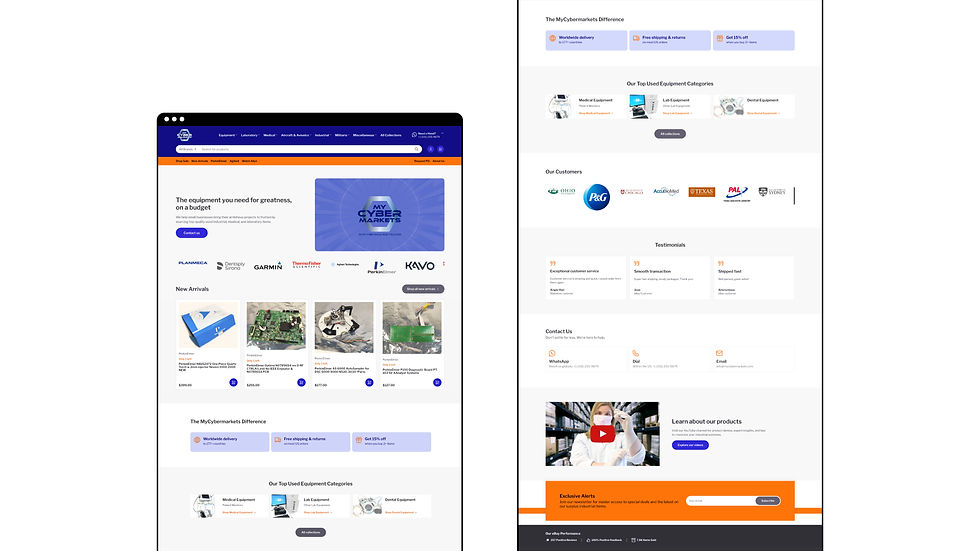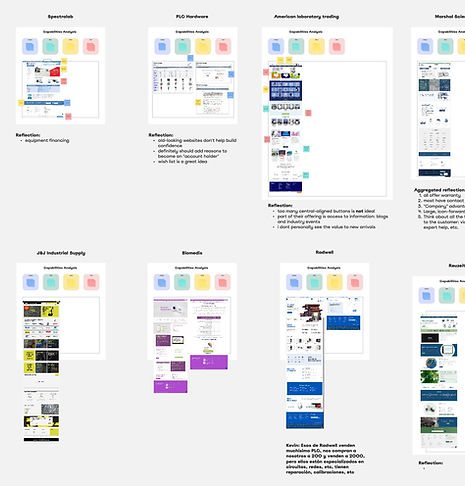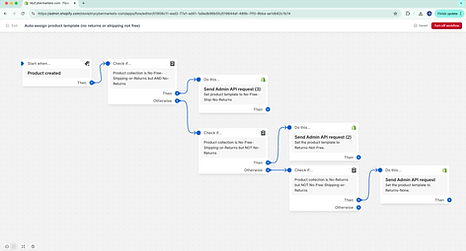
Redesigning the digital infrastructure of a lean multi-channel retailer
When a lean e-commerce company hit $1M in revenue selling surplus industrial parts, it found itself at a crossroads: how to grow beyond eBay, regain control over its customer experience, and build the infrastructure needed to scale.
I was brought on as the company’s first and only designer, tasked with reviving its neglected Shopify site, integrating a centralized inventory system, and creating a consistent, scalable brand presence across digital channels.
Shopify became a viable, self-owned channel—generating $7,152 in the first two months post-launch and now sustaining over $5,000/month in ongoing revenue.
ROLE
Product Designer (Web, UX, Systems)
Owned digital storefront design, Shopify customization, inventory integration workflows, internal documentation, and brand guidelines. Sole designer on a 6-person team.
DURATION
12 months
TOOLS
Shopify CMS, Shopify Flow, Liquid (code), 3D Sellers, Google Analytics, Canva, Excel, Loom, Figma (light)
COLLABORATORS
Daniela Urquiola— Director of E-Commerce
Kevin Duran— Product Strategist
Mafer Dompablo— Product Specialist
Cesar Anzola— CEO

PROBLEM
The business was growing, but the infrastructure wasn’t. Sales depended almost entirely on eBay, with no control over customer relationships or brand experience—and no backup plan if eBay pulled the plug.
Shopify was barely used. Product data lived in scattered spreadsheets. Listing was manual and error-prone. The brand lacked structure. The company had momentum, but no system to support it.

Product listing funnel showing the disparity between eBay and Shopify listing volume.
APPROACH
Stage 1 — Redesigned the Shopify storefront and rebuilt internal workflows to support consistent, scalable listing
Stage 2 — Implemented a centralized inventory system to enable cross-platform selling
Stage 3 — Developed a lightweight brand system to unify the company’s visual identity across marketing and operations

Diagram visualization of the three project stages.
RESULTS
The three-part redesign—across website, inventory, and brand—transformed how the company operated and sold online. A lean team now runs a stable, multi-channel system with room to grow.
389%
increase in Shopify sales
post-launch, stabilizing at over $5,000/month, or $60K+ annually
33%
more products uploaded daily
with a centralized workflow adopted by the team
4+
consistent brand touchpoints
applied to Shopify, eBay, YouTube, and internal tools
STAGE 1 — WEBSITE REDESIGN
Reviving a Trustworthy Sales Channel
WEBSITE
PROCESS
As the company’s only designer, I led the effort to bring Shopify back to life. With no dev support and a minimal budget, I focused on practical solutions: analyzing competitors, restructuring the site, customizing theme code, and automating internal workflows. I worked closely with stakeholders to ensure the site reflected how our buyers—and our inventory—worked in reality.
.jpg)
Analysis of competing industrial product resellers' websites.
WEBSITE
KEY CHANGES
-
Rebuilt homepage layout and menus based on user needs and internal logic
-
Defined product categories with operations and strategy teams

New product category hierarchy defined alongside internal inventory team.
INFORMATION ARCHITECTURE
{/}
THEME CUSTOMIZATION
-
Using Liquid code, I built a conditional check-out for prescription items
-
Added breadcrumb navigation
-
Customized default theme sections to achieve specific needs
Conditional check-out to stay compliant and ease admin workload.
OPERATIONAL ENHANCEMENTS
-
Created logic for per-product return policies using API calls and metafields
-
Integrated Google Analytics and Microsoft Clarity for continued SEO and conversation optimization
-
Added a “PO Request” tab in response to buyer messages

Automation using API requests to display product-specific data on product pages.
WEBSITE
RESULTS
389%
sales increase within two months of relaunch
Since my departure, the site has continued performing. It currently generates over $5,000/month in sustained revenue. What was once a neglected backup channel is now a profitable, high-trust foundation for the company’s future growth.
STAGE 2 — INVENTORY
Infrastructure for Multi-Channel Scale
INVENTORY
PROCESS
Operational pain-points abounded: product listing was fully manual (copy-pasted field-by-field!), inventory data was split between eBay's catalog and daily spreadsheets. The result was that Shopify was only used occasionally, due to the risk of overselling.
To solve this, we evaluated over 13 centralized inventory management tools using a custom rubric. I led the implementation end-to-end: configuring settings, mapping product data across platforms, conducting lean tests, and partnering with the platform’s support team to resolve persistent sync issues.

Previous listing process relied on manual uploads and disconnected spreadsheets.
INVENTORY
IMPLEMENTATION HIGHLIGHTS
LISTING RULES
Built and tested cross-platform listing rules to ensure compatibility, enabling risk-free synchronization to multiple marketplaces.
Centralized inventory displays product data and active marketplace listings.
DATA CLEANUP / TECHNICAL DEBT
Cleaned and standardized product data, including SKUs, categories, shipping, and return policies enabling structured cross-listing with less manual work.
Thousands of products automatically mapped across eBay's, Google's and Shopify's differentiated product category taxonomy.
DOCUMENTATION AND TRAINING
Developed internal documentation and training materials to support long-term team adoption.
Library of training videos for the new e-commerce standard operating procedure.
INVENTORY
RESULTS
33%
more items listed in the same amount of time
The team adopted the tool as a core part of their daily workflow. Product uploads became measurably faster the team gained far greater control over inventory and customer data—replacing scattered spreadsheets with a reliable, centralized system they could build on.
STAGE 3 — BRAND SYSTEM
Bringing Consistency to Web, Marketing, and Ops
BRAND
PROCESS
The brand work began as a way to make Shopify look and feel trustworthy—there was no design system in place, just a logo, a favicon, and a decorative pattern. I developed a full visual language with digital usability in mind: choosing accessible colors, defining screen-friendly typography, and creating flexible layout rules.
I wireframed key homepage sections in Figma to test visual hierarchy, layout rhythm, and UI contrast before implementing in Shopify. Once the website was in good shape, I extended the system across other digital channels—creating tools and templates that non-designers on the marketing and e-commerce teams could use confidently.

Before and after comparison of the company's website home page.
BRAND
KEY CHANGES
Defined accessible color scales, UI typography, and layout logic tailored to e-commerce needs.
DIGITAL-FIRST VISUAL SYSTEM
Book included educational text and examples to help non-designers best.
BRAND TOOLS
Built a team-friendly brand book, icon system, email signature, and editable Canva templates for marketing assets.
Branded templates made on Canva for easier application.
MULTIMEDIA CONTENT
Produced branded assets like a store intro video, professional imagery, and flyers to increase brand equity.
Store promotional video for various channels.
BRAND
RESULTS
4+
touchpoints with consistent brand application
By creating a systematic brand and creating 10+ reusable templates for non designers, the brand now supports external channels and internal workflows and is described as "professional" and "easy to use" by the team.
OUTCOMES & REFLECTION
This project taught me how to build structure from scratch, even in an environment that lacked strategic clarity. I delighted in approaching design as a systems-level tool, not just a visual one, and found ease in working across operations, marketing, and product to create solutions that were both maintainable and meaningful. While some of my initiatives were limited by a lack of buy-in for design within leadership, I’m proud of what I accomplished and of the foundation I left behind for the team to build on.
TAKEAWAYS
NEXT STEPS
1. Design is most valuable when it solves the right problem, regardless of the tools used.
2. My role as a designer expands when I focus on what's needed, not just what's expected.
3. I thrive when I use design as a mindset to build solutions that last.
1. Shift more current customers away from eBay and into Shopify through incentives.
2. Continue expanding into other marketplaces like Facebook, while building stronger operational processes to support day-to-day execution.
3. Revisit plans for a customer management system to increase retention and repeat buying
